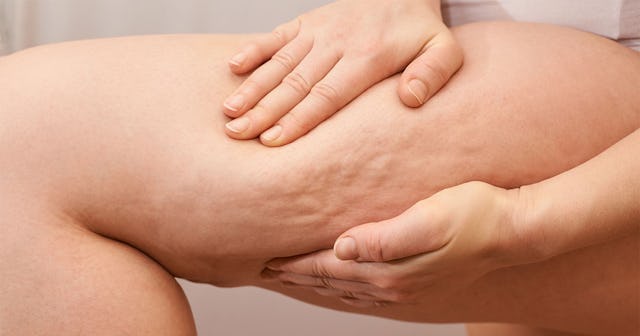There’s A New Treatment For Cellulite — Here’s What You Need To Know

Cellulite is common. Chances are, most people reading this have cellulite. That’s because cellulite affects 90% of women and 10% of men, according to Scientific American. Which means … absolutely nothing when it comes to our health or wellness.
Cellulite is not a symptom of old age, poor muscle tone, or bad diet. It just is. Cellulite is “not just predisposed to one particular type of woman,” according to Deanne Mraz Robinson, MD, an assistant clinical professor of dermatology at Yale University in New Haven and dermatologist at Modern Dermatology of Connecticut in Westport, who notes that she’s “treated many patients who were professional athletes or professional dancers.”
Cellulite is, by and large, purely a cosmetic issue. For some folks, however, it’s also an imperfection, a reason to feel self-conscious in a bathing suit. (Interestingly enough, cellulite wasn’t always seen as an imperfection, according to Anne Chapas, MD, founder and medical director of Union Square Laser Dermatology in New York City. Many famous artworks that celebrate the female form portray cellulite. But all of that is a separate conversation related to the problems inherent in diet culture.)
Enter cellulite treatments, like Qwo.
QWO Is The First Injectable For Cellulite
Over the years, the FDA has approved a number of treatments for cellulite. Most of those promise only temporary results. None are injectable.
QWO (a.k.a. collagenase clostridium histolyticum-aaes) is reportedly different. The FDA approved QWO in July 2020 and it became available in medi-spas in Spring 2021. Its goal is to reduce the appearance of cellulite in three rounds of injections (up to 12 per visit), administered 21 days apart.
Most people experienced some bruising after treatment — mostly local to the injection site, but possible over a larger area as well. Other side effects included pain, swelling, itching, and formation of nodules at the injection site.
One participant reported an allergic reaction. (Important to note: you should not get QWO if you are allergic to collagenase or any ingredient in QWO, or if you have an active infection around the treatment site.)
The way QWO works is “not fully understood.” It’s thought to “target a structural cause under your skin,” and ultimately releases the dimple making skin appear smooth. Unlike other approved cellulite treatments, QWO’s mechanism for reducing the appearance of cellulite is chemical versus mechanical (via thermal energy or otherwise).
As a result, QWO promises to be less invasive and requires less downtime post treatment.
Clinical Trial Results Are Good — But Not Mind-Blowing
QWO was effective in clinical trials, but some doctors weren’t impressed. Abigail Waldman, a clinical director of the Mohs and Dermatologic Surgery Center at Brigham and Women’s Hospital in Boston, called the results of an 800-plus person phase III clinical trial simply “all right,” in an interview with HuffPost.
She explained, “The outcome was measured in whether patients were slightly happier or much happier, basically. In both the Phase II and Phase III trials, around 60% of patients found they had any degree of improvement. So, it’s statistically significant but not a complete home run.”
Statistically significant is great, but it should also be considered in light of reservations doctors have.
Doctors Have Reservations About QWO
The biggest reservation among experts is with respect to the long-term effects of QWO. QWO is FDA-approved, but it hasn’t been around long enough to know whether its cellulite smoothing results are permanent or not or whether there might be any long-term unwanted consequences.
In a blog post, the American Board of Cosmetic Surgery noted that “longest that some patients were observed for risks and side effects was six months — and that was only a portion of the participants from the clinical study. This means that QWO’s long-term safety is not yet confirmed.”
Not only is long-term safety still a question mark, but how long its effects last is an unknown. The QWO website doesn’t provide specific data, but at least one provider offering QWO suggests the results will last for at least one year and may be permanent.
Because of QWO’s novelty, Walden urges potential patients to visit a board-certified dermatologist or board-certified plastic surgeon. She notes, “Side effects and complications are rare, but you want someone familiar with the anatomy who can manage complications.”
No Magic Bullet For Cellulite
Teo Soleymani, a clinical health sciences instructor and dermatologic surgeon at UCLA Health advised folks to remember that “Unfortunately, [QWO is] not a magic bullet for all cellulite.” He urged caution, noting that QWO might not be right for everyone. Those who have large areas of dimpling or those who’ve tried other cellulite reduction methods may not be great candidates for QWO.
Ultimately, as with most things in the field of cosmetic surgery, procedure, of enhancement, you should seek the advice of a trusted medical professional and decide what works for you. The goal is to be happy in your own skin, in a way that feels right to you. Maybe that’s QWO — and maybe it’s not.
This article was originally published on